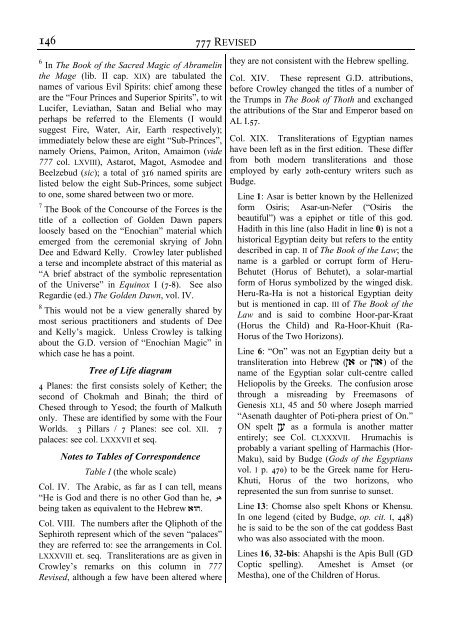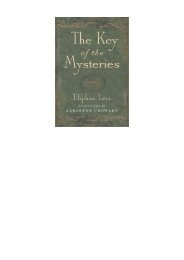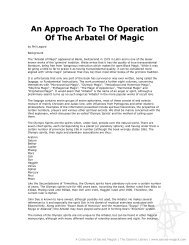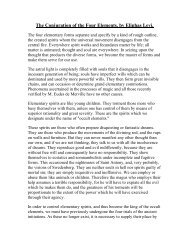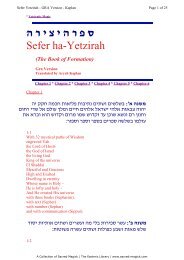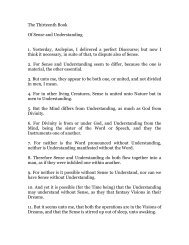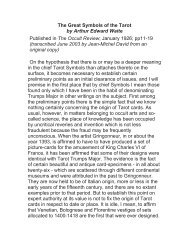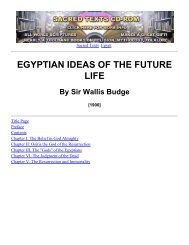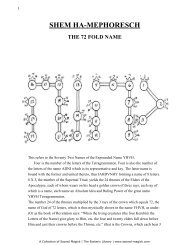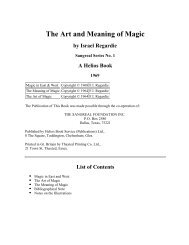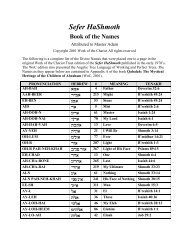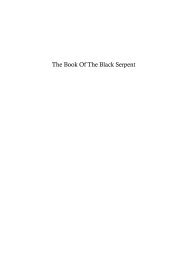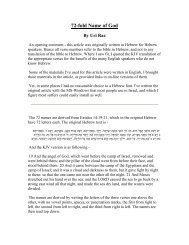Liber 777 (revised) (pdf) - Holy Order of the Golden Dawn Canada
Liber 777 (revised) (pdf) - Holy Order of the Golden Dawn Canada
Liber 777 (revised) (pdf) - Holy Order of the Golden Dawn Canada
Create successful ePaper yourself
Turn your PDF publications into a flip-book with our unique Google optimized e-Paper software.
146<br />
<strong>777</strong> REVISED<br />
6<br />
In The Book <strong>of</strong> <strong>the</strong> Sacred Magic <strong>of</strong> Abramelin<br />
<strong>the</strong> Mage (lib. II cap. XIX) are tabulated <strong>the</strong><br />
names <strong>of</strong> various Evil Spirits: chief among <strong>the</strong>se<br />
are <strong>the</strong> “Four Princes and Superior Spirits”, to wit<br />
Lucifer, Leviathan, Satan and Belial who may<br />
perhaps be referred to <strong>the</strong> Elements (I would<br />
suggest Fire, Water, Air, Earth respectively);<br />
immediately below <strong>the</strong>se are eight “Sub-Princes”,<br />
namely Oriens, Paimon, Ariton, Amaimon (vide<br />
<strong>777</strong> col. LXVIII), Astarot, Magot, Asmodee and<br />
Beelzebud (sic); a total <strong>of</strong> 316 named spirits are<br />
listed below <strong>the</strong> eight Sub-Princes, some subject<br />
to one, some shared between two or more.<br />
7<br />
The Book <strong>of</strong> <strong>the</strong> Concourse <strong>of</strong> <strong>the</strong> Forces is <strong>the</strong><br />
title <strong>of</strong> a collection <strong>of</strong> <strong>Golden</strong> <strong>Dawn</strong> papers<br />
loosely based on <strong>the</strong> “Enochian” material which<br />
emerged from <strong>the</strong> ceremonial skrying <strong>of</strong> John<br />
Dee and Edward Kelly. Crowley later published<br />
a terse and incomplete abstract <strong>of</strong> this material as<br />
“A brief abstract <strong>of</strong> <strong>the</strong> symbolic representation<br />
<strong>of</strong> <strong>the</strong> Universe” in Equinox I (7-8). See also<br />
Regardie (ed.) The <strong>Golden</strong> <strong>Dawn</strong>, vol. IV.<br />
8 This would not be a view generally shared by<br />
most serious practitioners and students <strong>of</strong> Dee<br />
and Kelly’s magick. Unless Crowley is talking<br />
about <strong>the</strong> G.D. version <strong>of</strong> “Enochian Magic” in<br />
which case he has a point.<br />
Tree <strong>of</strong> Life diagram<br />
4 Planes: <strong>the</strong> first consists solely <strong>of</strong> Ke<strong>the</strong>r; <strong>the</strong><br />
second <strong>of</strong> Chokmah and Binah; <strong>the</strong> third <strong>of</strong><br />
Chesed through to Yesod; <strong>the</strong> fourth <strong>of</strong> Malkuth<br />
only. These are identified by some with <strong>the</strong> Four<br />
Worlds. 3 Pillars / 7 Planes: see col. XII. 7<br />
palaces: see col. LXXXVII et seq.<br />
Notes to Tables <strong>of</strong> Correspondence<br />
Table I (<strong>the</strong> whole scale)<br />
Col. IV. The Arabic, as far as I can tell, means<br />
“He is God and <strong>the</strong>re is no o<strong>the</strong>r God than he, ﻮه<br />
being taken as equivalent to <strong>the</strong> Hebrew awh.<br />
Col. VIII. The numbers after <strong>the</strong> Qliphoth <strong>of</strong> <strong>the</strong><br />
Sephiroth represent which <strong>of</strong> <strong>the</strong> seven “palaces”<br />
<strong>the</strong>y are referred to: see <strong>the</strong> arrangements in Col.<br />
LXXXVIII et. seq. Transliterations are as given in<br />
Crowley’s remarks on this column in <strong>777</strong><br />
Revised, although a few have been altered where<br />
<strong>the</strong>y are not consistent with <strong>the</strong> Hebrew spelling.<br />
Col. XIV. These represent G.D. attributions,<br />
before Crowley changed <strong>the</strong> titles <strong>of</strong> a number <strong>of</strong><br />
<strong>the</strong> Trumps in The Book <strong>of</strong> Thoth and exchanged<br />
<strong>the</strong> attributions <strong>of</strong> <strong>the</strong> Star and Emperor based on<br />
AL I.57.<br />
Col. XIX. Transliterations <strong>of</strong> Egyptian names<br />
have been left as in <strong>the</strong> first edition. These differ<br />
from both modern transliterations and those<br />
employed by early 20th-century writers such as<br />
Budge.<br />
Line 1: Asar is better known by <strong>the</strong> Hellenized<br />
form Osiris; Asar-un-Nefer (“Osiris <strong>the</strong><br />
beautiful”) was a epiphet or title <strong>of</strong> this god.<br />
Hadith in this line (also Hadit in line 0) is not a<br />
historical Egyptian deity but refers to <strong>the</strong> entity<br />
described in cap. II <strong>of</strong> The Book <strong>of</strong> <strong>the</strong> Law; <strong>the</strong><br />
name is a garbled or corrupt form <strong>of</strong> Heru-<br />
Behutet (Horus <strong>of</strong> Behutet), a solar-martial<br />
form <strong>of</strong> Horus symbolized by <strong>the</strong> winged disk.<br />
Heru-Ra-Ha is not a historical Egyptian deity<br />
but is mentioned in cap. III <strong>of</strong> The Book <strong>of</strong> <strong>the</strong><br />
Law and is said to combine Hoor-par-Kraat<br />
(Horus <strong>the</strong> Child) and Ra-Hoor-Khuit (Ra-<br />
Horus <strong>of</strong> <strong>the</strong> Two Horizons).<br />
Line 6: “On” was not an Egyptian deity but a<br />
transliteration into Hebrew (}a or }wa) <strong>of</strong> <strong>the</strong><br />
name <strong>of</strong> <strong>the</strong> Egyptian solar cult-centre called<br />
Heliopolis by <strong>the</strong> Greeks. The confusion arose<br />
through a misreading by Freemasons <strong>of</strong><br />
Genesis XLI, 45 and 50 where Joseph married<br />
“Asenath daughter <strong>of</strong> Poti-phera priest <strong>of</strong> On.”<br />
ON spelt }o as a formula is ano<strong>the</strong>r matter<br />
entirely; see Col. CLXXXVII. Hrumachis is<br />
probably a variant spelling <strong>of</strong> Harmachis (Hor-<br />
Maku), said by Budge (Gods <strong>of</strong> <strong>the</strong> Egyptians<br />
vol. I p. 470) to be <strong>the</strong> Greek name for Heru-<br />
Khuti, Horus <strong>of</strong> <strong>the</strong> two horizons, who<br />
represented <strong>the</strong> sun from sunrise to sunset.<br />
Line 13: Chomse also spelt Khons or Khensu.<br />
In one legend (cited by Budge, op. cit. I, 448)<br />
he is said to be <strong>the</strong> son <strong>of</strong> <strong>the</strong> cat goddess Bast<br />
who was also associated with <strong>the</strong> moon.<br />
Lines 16, 32-bis: Ahapshi is <strong>the</strong> Apis Bull (GD<br />
Coptic spelling). Ameshet is Amset (or<br />
Mestha), one <strong>of</strong> <strong>the</strong> Children <strong>of</strong> Horus.


